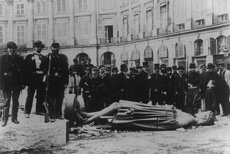|
|
Place Vend˘me is a square in the 1st arrondissement of Paris located to the north of the Tuileries Gardens and east of the ╔glise de la Madeleine. It is the starting point of the Rue de la Paix. Its regular architecture by Jules Hardouin-Mansart and pedimented screens canted across the corners give the rectangular Place Vend˘me the aspect of an octagon.
After some false starts, the Place was laid out in 1702 as a monument to the glory of the armies of Louis XIV, the Grand Monarque and called Place des Conquetes, to be renamed Place Louis le Grand, when the conquests proved temporary; an equestrian statue of the king was set up in its center.
Napoleon erected the present column, modelled after Trajan's Column, to celebrate the victory of Austerlitz; its spiralling veneers of bas-relief bronze plates (by the sculptor Pierre-Nolasque Bergeret) were made out of cannon taken from the combined armies of Europe, according to his propaganda. (The usual figure given is hugely exaggerated: 133 cannon were actually captured at Austerlitz.) After the Bourbon restoration the statue of the Emperor was pulled from the top of the column and refinished as a statue of Henri IV, which can be inspected on the Pont Neuf. A replacement statue of Napoleon, however, was erected by Louis-Philippe, and a better, more augustly classicizing one by Louis-Napoleon. The column was pulled down by a gang of Communards in 1871, with the painter Gustave Courbet at their head, but was set up again in the early days of the Third Republic, and there it remains.
The site of the square was formerly the hôtel of César, duc de Vend˘me, the illegitimate son of Henri IV and his mistress Gabrielle d'EstrÚes. Mansart bought the building and its gardens, with an idea of converting it into building lots as a profitable speculation. The plan didn't materialize, and Louis XIV's minister of finance, Louvois, purchased the piece of ground, with the object of building a square, modelled on the successful Place des Vosges of the previous century. Louvois came into financial difficulties and nothing came of his project, either. After his death the king purchased the plot and commissioned Mansart to design a housefront that the buyers of plots round the Place would agree to adhere to. When the state finances ran low, the financier John Law took on the project, built himself a residence behind one of the facades, and the square was complete by 1720, just as his paper-money Mississippi bubble burst.
At the centers of the square's long sides, Mansart's range of Corinthian pilasters breaks forward under a pediment, to create palace-like fronts. The arcading of the formally rusticated ground floors does not provide an arcaded passageway as at Place des Vosges. The architectural linking of the windows from one floor to the next, and the increasing arch of their windowheads, provide an upward spring to the horizontals formed by ranks of windows. Originally the Place was accessible by a single street and preserved an aristocratic quiet, except when the annual fair was held there. Then Napoleon opened the Rue de la Paix, and the 20th century filled the Place Vend˘me with traffic.
The Place Vendome has been famous for its fashionable and deluxe hotels: The H˘tel Ritz Paris, which is the Ritz, and the Bristol, which Edward VII preferred, now called the Vend˘me. Many famous dress designers have had their salons in the square.
External links
- Place Vend˘me and its history (http://www.oldandsold.com/articles03/paris2.shtml)
- Lucy Komisar, "The Intriguing Past and Present of the Place Vend˘me in Paris" (http://www.travellady.com/Issues/December03/TheIngriguingPastandPresent.htm)
Place Vend˘me provided a title for a 1998 movie starring Catherine Deneuve.de:Place Vend˘me
fr:Place Vend˘me
nl:Place Vend˘me

